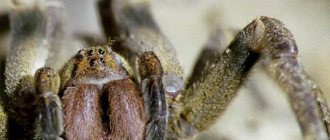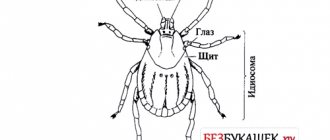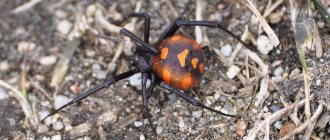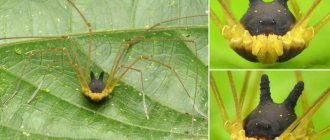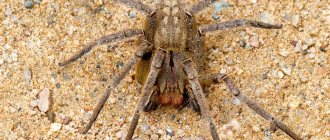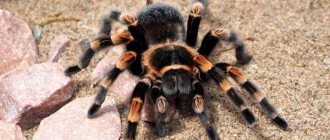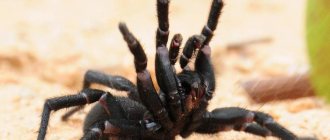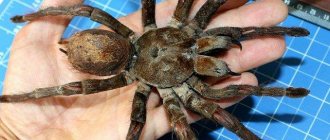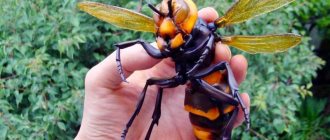Nephila goldweaver
Nephil the golden weaver occupies tenth place in the ranking. The spider got its name thanks to its web. When the sun's rays fall on it, you might think that it is woven from golden threads. During the weaving process, the spider is able to change the color of the pigment of the threads, making it less noticeable to insects in dark or light areas. The strength of the web allows you to catch birds, bats and even snakes. The thread contains a chemical compound designed to repel ants.
Only female individuals weave a strong web with a golden hue. These spiders are prone to sexual dimorphism; females are almost 5 times larger than males in size. The limb span of females reaches 13 cm, and the total length of the male is only 2.5 cm.
Spider venom is toxic, but not fatal to humans. There may be redness and pain at the site of the bite.
It lives in warm regions of the planet - South America, Australia, Asia, Africa and Madagascar. Hides in forests with sandy soil.
Interesting: Fishermen use the nephil web instead of a fishing net, it is so strong.
Tegenaria wall
Tegenaria or house spider is a large spider that lives in human homes. Listed in the Voronkov family, its networks resemble the shape of funnels.
The legs of Tegenaria reach an average of 10 cm, and the size of the body is several cm. As a result, the full size, taking into account the span of the legs, can reach an impressive 15 cm. The color of the body is dominated by light brown shades, and the limbs are covered with dark stripes. Adults have several black stripes on their backs.
The house spider likes to hide under tree bark or fallen leaves. This species of spider is considered harmless. It is not capable of causing serious harm and is not poisonous.
Pecilotheria rufilata
This tarantula spider grows up to 8 cm, and taking into account the paw span, up to 23-24 cm. It can be found in the southeast of India. Adults make their nests mainly in hollows or tree branches, while young animals prefer to stay close to the ground.
Rufilata has a very rich greenish color with yellow and dark brown patches on the legs. His entire body is covered with red hair, with the exception of his abdomen.
Like all tarantulas, it eats insects, lizards, birds, and will not neglect small rodents. Although this spider is very aggressive, there are many who want to keep it as a pet.
Brazilian wandering spider
The Brazilian wandering spider is always on the move and does not spin a web, which is why it got its nickname. It can be found in southern North America and southern Central America.
During the daytime, it hides under stones and fallen logs, in bromeliads and plants of the banana family. In areas with high population densities, it can be found in boxes, clothes, shoes, near homes and even in cars.
The total length reaches 17 cm, and the length of the body is 5–7 cm. The color is in light brown shades with light patterns in the belly area. There are thin dark stripes on both sides of the head, a dark stripe in the middle of the cephalothorax and several dark stripes on the front legs.
It is one of the top 10 most poisonous spiders; its poison is dangerous to human life. Serious consequences can be avoided by immediately going to the hospital.
Interesting fact: The spider loves to eat bananas, which is why it received the nickname banana spider.
Video
And in conclusion, we invite you to watch an interesting documentary about tarantulas - “Tarantula - The Australian King of Spiders”.
Author: Pavel Chaika, editor-in-chief of Poznavaika magazine
When writing the article, I tried to make it as interesting, useful and high-quality as possible. I would be grateful for any feedback and constructive criticism in the form of comments on the article. You can also write your wish/question/suggestion to my email [email protected] or Facebook, with respect, the author.
Author page
This article is available in English -
Tarantula Spider.
Cerbal Arabian
Cerbal Arabian was discovered by zoologists in Israel relatively recently, hence its name. The spider prefers a nocturnal lifestyle, which is why it was not discovered before and very little is known about it. Habitat: deserts.
The total size of the spider with outstretched legs reaches 20 cm. Males are always smaller than females. The color camouflages it for existence in sandy conditions, it is usually pale yellow or beige in color, with black spots on the legs.
It is not dangerous for people.
You can also read on our website which is the largest rat that lives on our planet.
Giant baboon spider
This giant spider got its name due to the similarity of the shape of its legs to the limbs of monkeys. Member of the tarantula family. Lives in tropical forests and subtropics. Because of its habitat, it is often called the African tarantula.
The limb span reaches 20 cm, and the total length reaches 30 cm. It is found in tropical forests and belongs to a burrowing species. It has a red-brown color with shades of orange. The paws are covered with shaggy hairs.
It poses a danger to humans with its poison, but never attacks first. When defending, it hisses like a snake, knocks with its front legs and stands on its hind legs, pretending to look intimidating. The spider is active at night. He hunts crickets and butterflies, small mice, and does not disdain his relatives.
Nutrition
As you probably already guessed, tarantulas are notorious predators, their food consists of numerous small insects and amphibians: caterpillars, mole crickets,
crickets, beetles, cockroaches, small frogs, etc. Tarantulas watch their prey from a hiding place and then quickly attack. Having attacked, they paralyze the prey with their poison, which subsequently turns its insides into a nutritious liquid, then the tarantula sucks it out like a “cocktail”.
The process of absorption of food by a tarantula can last several days, but in general they are not very voracious and can do without food for a long time, as long as they have access to water.
Purple tarantula
One of the largest spiders in the world is the Colombian purple tarantula spider. Belongs to the tarantula family. Lives in tropical rainforests of South America.
The body measures 9–11 cm, and together with the paws reaches a length of more than 34 cm. The body and paws are covered with dark velvet-like hairs, the hairs are thicker towards the base of the paws, which allows it to move both on rocky surfaces and soft soil.
It feeds not only on birds, but also on various rodents, amphibians and insects.
Interesting fact: Its furry cover and interesting color attract the attention of spider lovers. The tarantula is often kept at home. However, the spider is extremely aggressive, contact with it can cause an allergic disease.
Camel spider
The camel spider has many alternative names, such as bihorca, salpuga or phalanx. It is part of the order Solifugae, which is Latin for “sunlight runner.” However, this does not mean at all that he is afraid of the sun. Among the species from this order there are many sun-loving arachnids. Lives in the deserts of most continents.
The spider's paw span is up to 30 cm, and its body size is 8 cm. The color is brown-yellow, closer to orange. The limbs and body are covered with hairs, and tentacles protrude from the front.
Prefers night time, hunts lizards, mice, chicks, beetles and some other animals.
Keeping at home
Recently, some exotic pet lovers have been getting pet tarantulas. And why not, because they are quite easy to keep and can live in an aquarium or terrarium. At the bottom of the container it is necessary to pour a substrate consisting of a mixture of sand, clay and earth. Also, the tarantula terrarium should be equipped with an automatic drinker with fresh water and a shallow pool.
The optimal temperature for keeping these spiders should be 25-27 C. You can feed tarantulas with small pieces of fresh beef, as well as live cockroaches and frogs, if, of course, you can catch them. But fortunately, you don’t need to feed them often, so for an adult healthy tarantula it will be normal to eat once a week.
It is also important to remember that only one tarantula can be kept in a terrarium; if there are two of them, then as a result of constant skirmishes only one, the strongest, will survive.
Pink tarantula spider
The pink-haired tarantula is what it is called in the northern Atacama Desert. It lives in the territory from northern Chile to the southwestern United States. It is also called the Chilean - fiery or orange tarantula.
The body size of the tarantula reaches 10 cm, and the leg span is 30 cm. The color with pink shades is not the only one; the Chilean tarantula also stands out with red-brown shades. The hairs on the body are pink. Females are larger than males, their body weighs about 100 grams, and males boast rather long legs.
The tarantula attacks its prey with lightning speed, leaving no chance. In defense, he shakes off allergenic hairs that contain poison and raises his front paws. Its poison is not dangerous to people, but can cause allergies and burning.
Reproduction and lifespan
tarantula spider matures faster than any of the females, but after that it lives no more than a year, and if it manages to mate, then even less. His readiness to have offspring can be guessed by his characteristic external signs. Firstly, bulbs are formed on his pedipalps - natural vessels for sperm.
Males also develop special hooks called tibal hooks, which play a certain role during mating. These devices are needed to hold the partner, as well as protection from her, since the chosen ones of spiders can turn out to be very aggressive individuals.
With the help of arranged webs and hairs on the body, the tarantula senses everything around
In preparation for a meeting with the “lady,” males weave a special web, secreting a drop of family fluid onto it, then grab it with hooks and begin searching for a partner.
But even when the spider is there and responds to the call, showing consent with all her appearance, intercourse does not occur without performing the required rituals. Without them, spiders are unable to determine whether they belong to the same species. This may include bodily shaking or paw tapping. Each variety has its own mating movements.
The intercourse itself can be instantaneous, but sometimes it lasts for hours. And the process consists of the male’s pedipalps transferring his sperm inside the partner’s body.
Such games are completely unsafe for spiders. Some of them may suffer even before copulation if the couple does not get along with each other (this happens more often in aggressive species). And after the act itself, the male usually flees for his life, since if he does not show agility, he may well end up eaten by a hungry female.
Next, the process of egg formation occurs in the spider’s body. And when the time comes, she forms a nest of cobwebs, where those same eggs are laid. Their number varies, in some species it is in the tens, and in others it reaches a couple of thousand.
After completing this, the spider makes a special spherical cocoon and incubates it. This period lasts differently for different species (it can last twenty days or more than a hundred). Moreover, the female can guard her offspring with aggressiveness and zeal, and can even eat the entire farm if she is hungry.
That's the nature of spiders. From the mentioned cocoons, nymphs first emerge, molt and grow, turning first into larvae and then into adult spiders.
Nature has given females a longer lifespan than their male counterparts. Spiders are considered the champions among arthropods in terms of lifespan. The record is 30 years old. But, strictly speaking, the duration of the life cycle depends on the species, and is sometimes measured in ten years, but in some varieties it is only a few years.
Giant crab or spider hunter
The long and curved limbs that resemble a crab are the reason for its name. The arthropod lives in Australia.
The size of females reaches 30 cm, males are one and a half times smaller. It has several types of color ranging from light gray to dark brown. In the photo you can clearly see the powerful jaws.
Unusual legs allow it to crawl into cracks, quickly climb trees and move sideways. The crab spider runs fast and jumps high. Its bite is not dangerous for humans, but irritation and discomfort may form at the site of the bite.
Goliath tarantula
The Goliath tarantula takes an honorable first place in the top 10 largest spiders in the world. This is the largest and most terrible spider on earth, the largest species of tarantula.
The weight of the largest spider on the planet is about 200 grams, the leg span reaches 30 cm, and the body size is as much as 12 cm.
The color of the largest tarantula is brown and all its shades; in the mouth there are large fangs with poison, measuring 3 cm or more. The paws have reddish hairs and transverse white stripes. Hides in damp and deep holes.
The largest species of this tarantula was listed in the Guinness Book of Records, the span of its limbs was 28 cm. This giant lives in the lands of South America.
During a hunt, the tarantula attacks the victim with lightning speed, grabs it with its predatory teeth and sheds hairs with paralyzing poison. It chooses insects, rodents and amphibians as victims. Despite the name, it rarely touches birds.
Goliath is practically not dangerous; its venom can cause the development of allergic reactions and severe pain at the site of the bite, due to its giant fangs. When defending themselves, they can stand on their hind legs and shoot at the offender with their spiky hair. Hairs can get stuck in the skin and cause irritation.
Lifestyle and habitat
Different types of such spiders take root in a wide variety of geographical areas and conditions. Among these representatives of the fauna, settlers of arid places and even deserts are known. There are species that prefer equatorial forests with their tropical humidity.
Arboreal tarantulas spend their days on bushes and trees, in their crowns among the branches. They weave webs and roll them into tubes. Others prefer solid ground and find shelter in this environment. There are quite a few species of spiders that dig holes for themselves that go deep underground. They cover their entrances with cobwebs.
Tarantulas can live in burrows (burrows) and trees
In addition, the habitat of these creatures largely depends on the stage of development of the individual. For example, as a larva, it spends its days in a hole, and when it grows up it begins to go out onto the ground (this happens in semi-arboreal and terrestrial species). That is, the behavior pattern of these spiders may change as they grow and mature.
Regarding the growth stages of such living beings. Newborn spiders that have just emerged from eggs are called nymphs. During this period of development, they usually do not need food.
Next, the nymphs, undergoing a couple of molts, during which rapid growth of the body occurs, turn into a larva (this is what spiders are called until they reach adulthood).
The hairs covering the body of such creatures are saturated with poison. For their owners themselves, this is a very useful acquisition they received from Mother Nature. Tarantulas use such fur shoots to protect nests by weaving them into webs.
Also, anticipating danger, they spread poisonous hair around themselves, thereby providing themselves with protection. If they enter the body through inhalation, even a person may experience painful symptoms: weakness, suffocation, burning - all these are signs of an allergic reaction.
Tarantula spiders are not particularly mobile. And if they break this rule, then only if there is a good reason. For example, female tarantulas, if they are well-fed, can sit in their shelters for several months. But even hungry individuals are motionless and patient. They are in their ambushes and stalk their prey.
